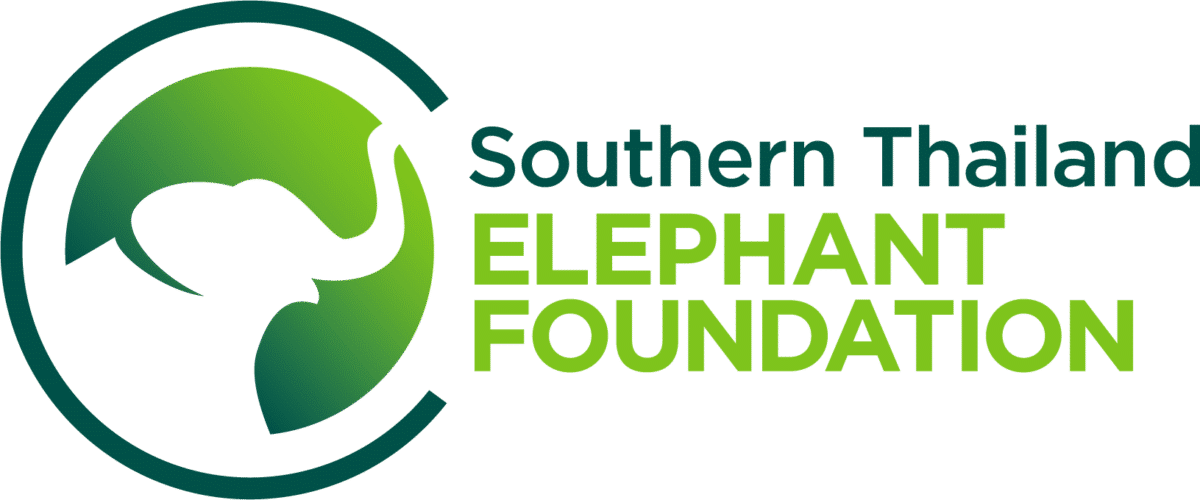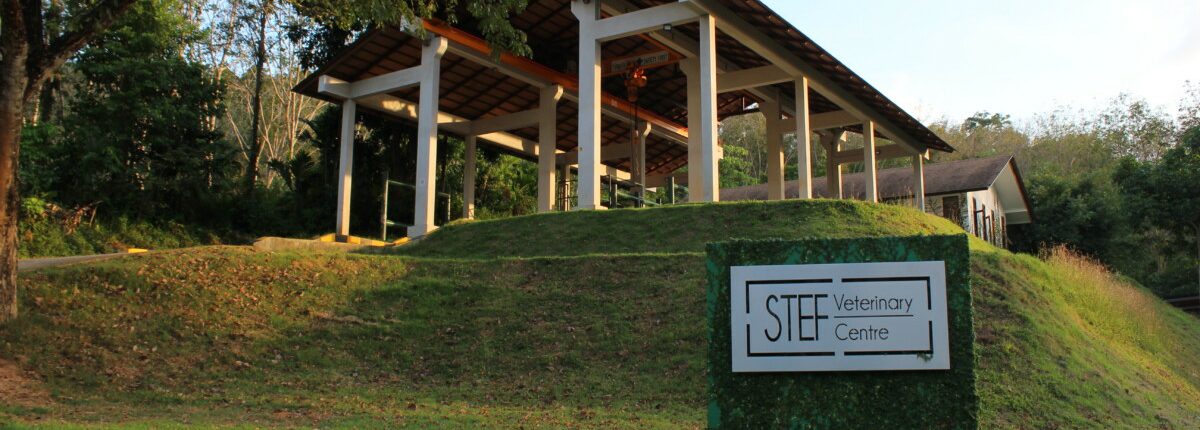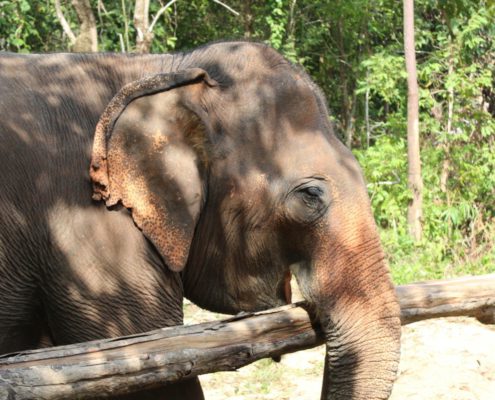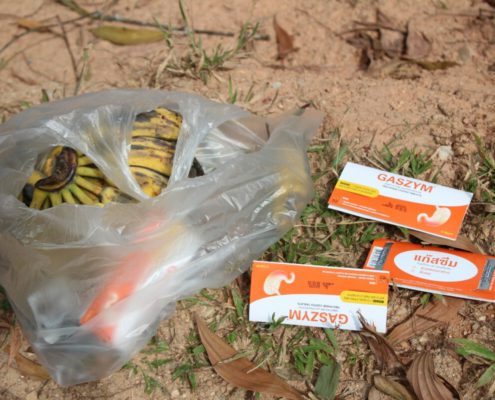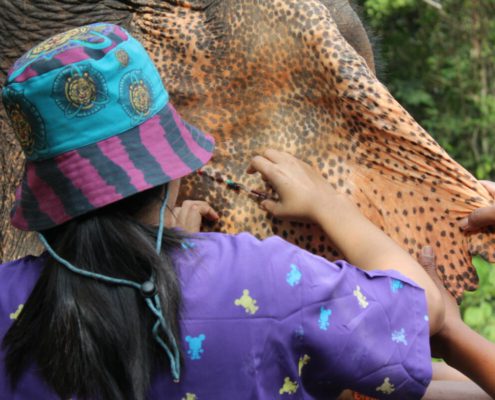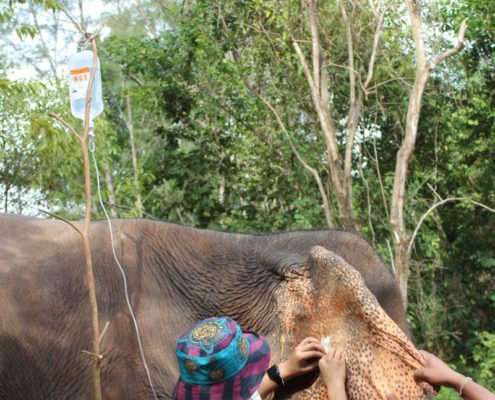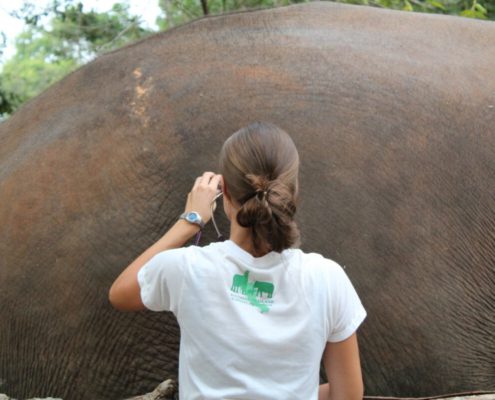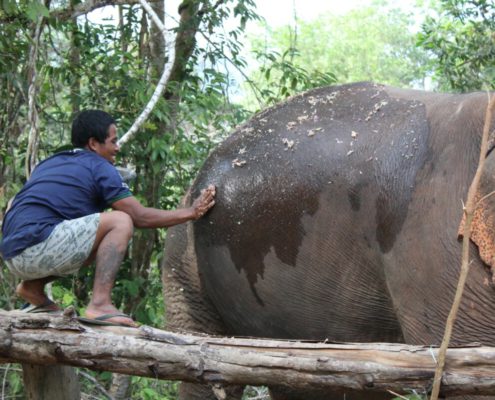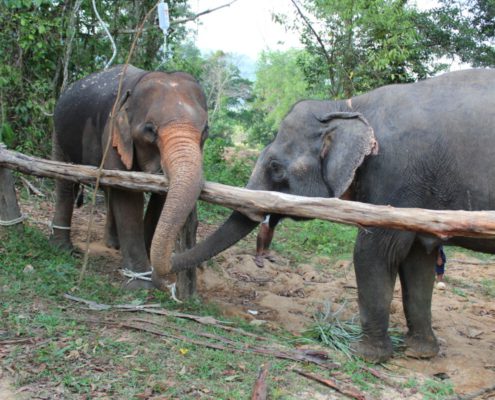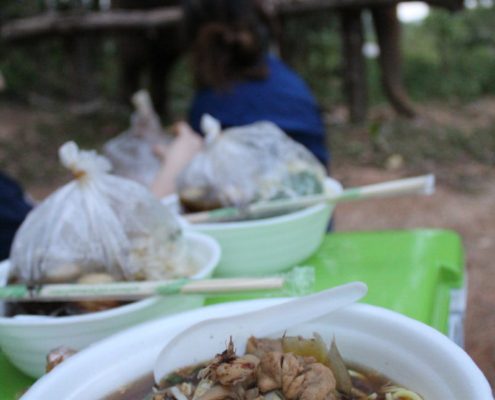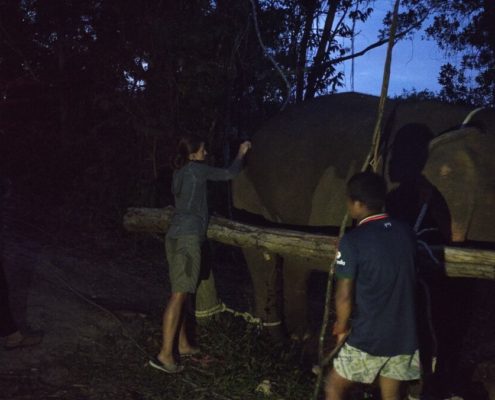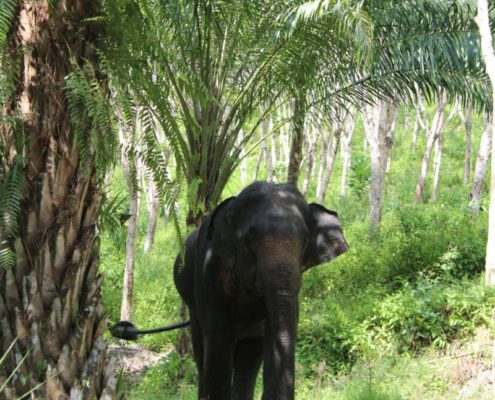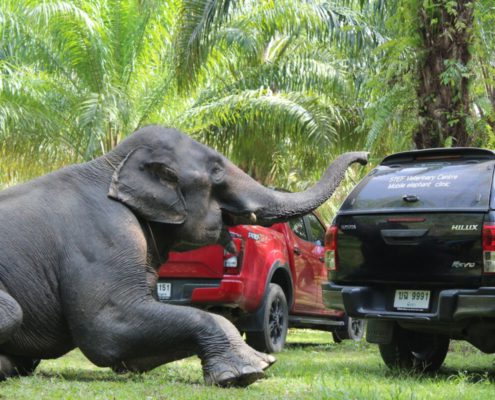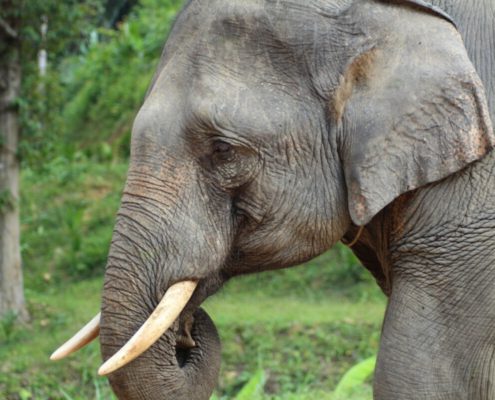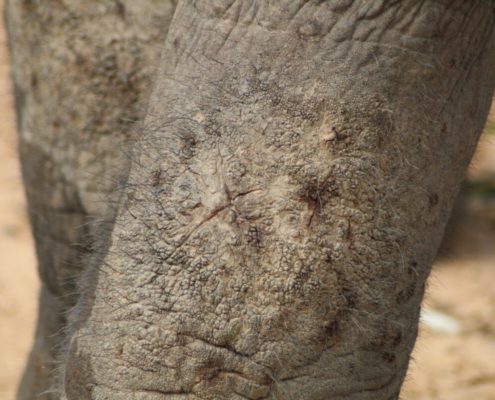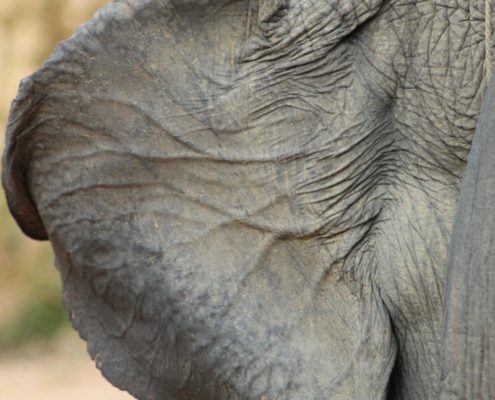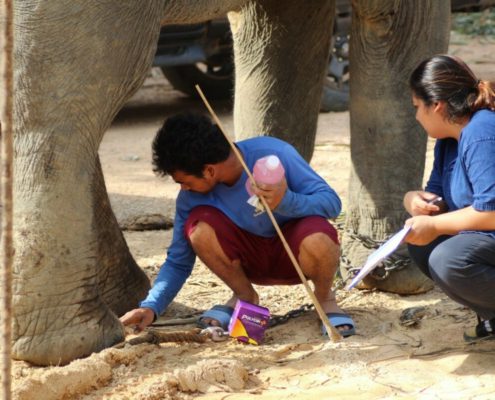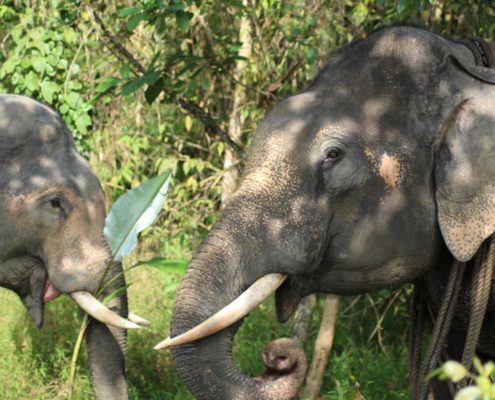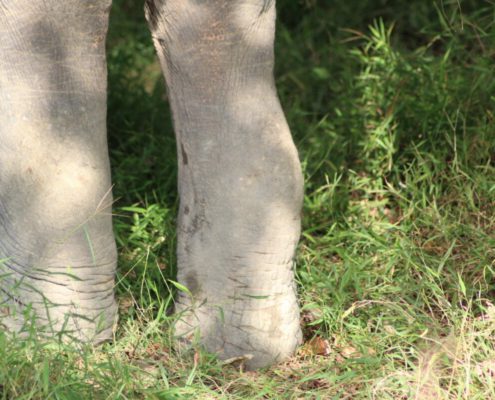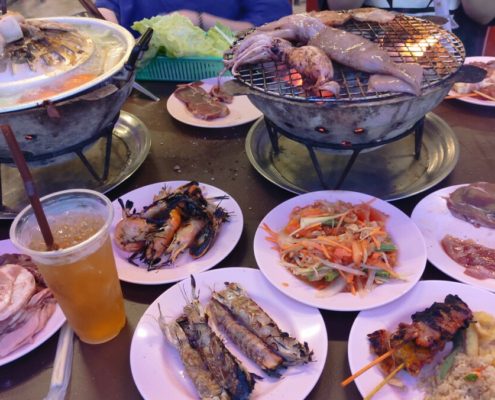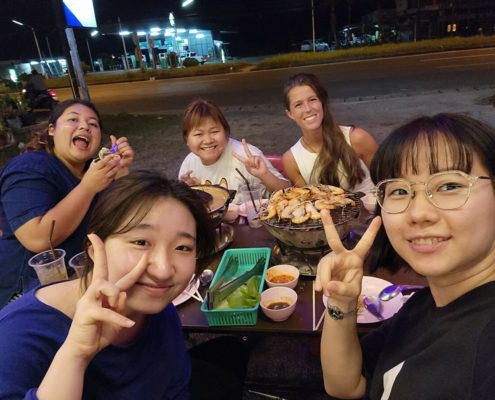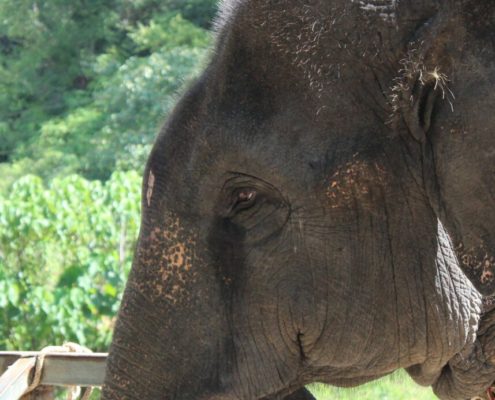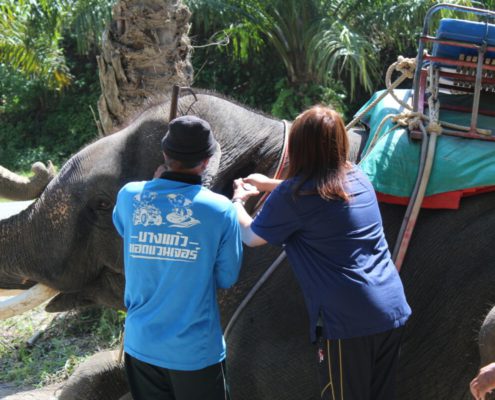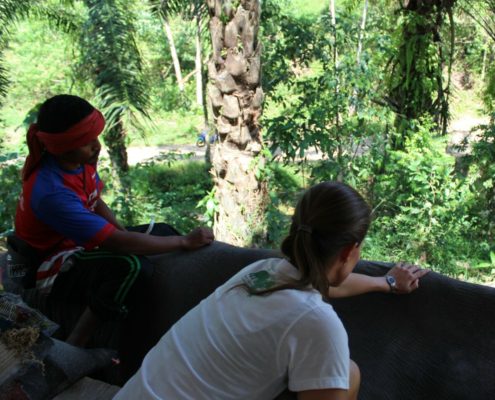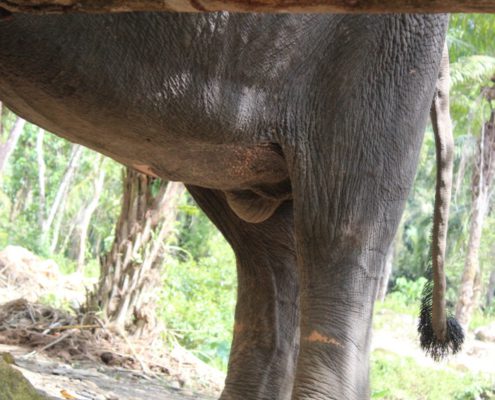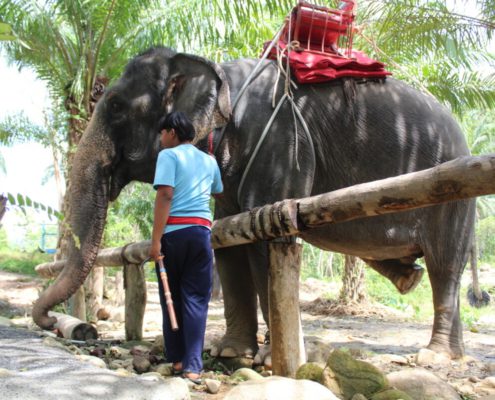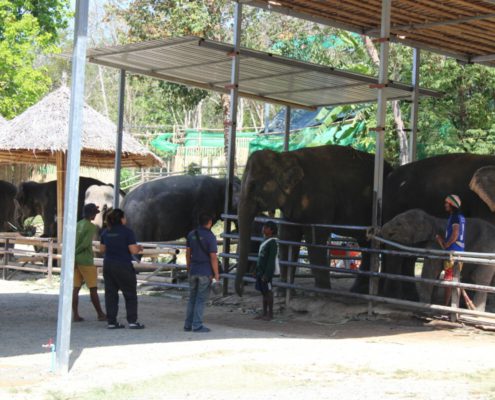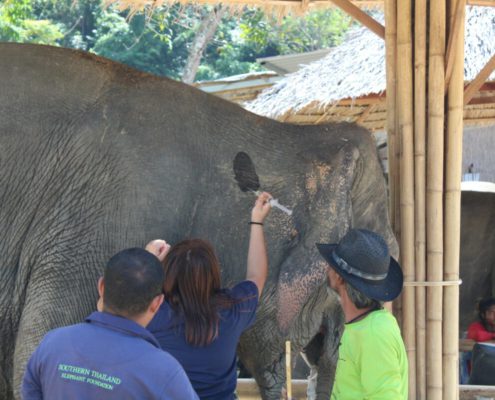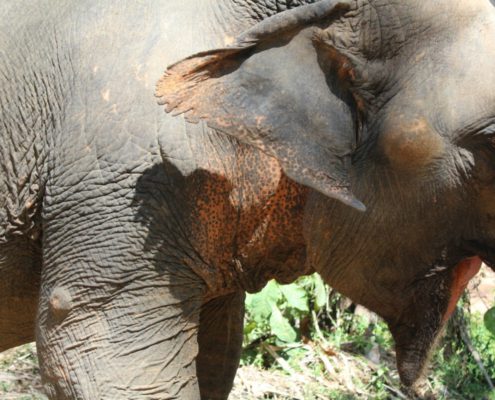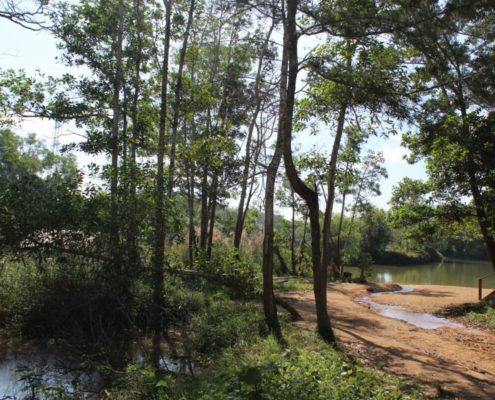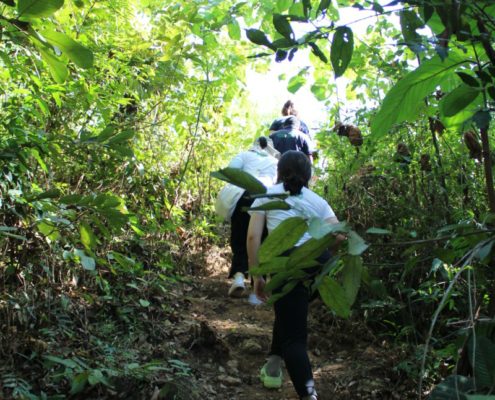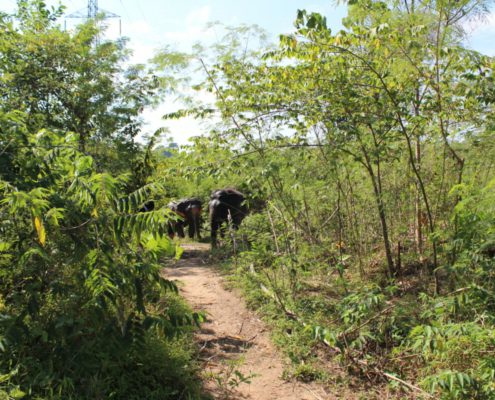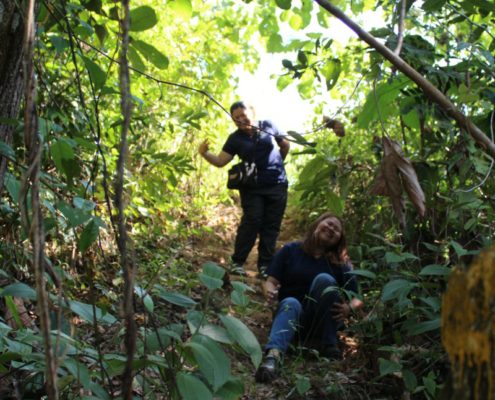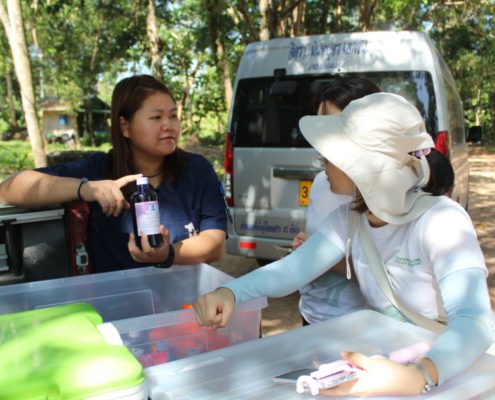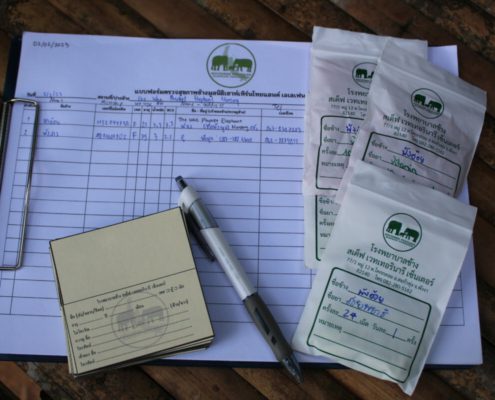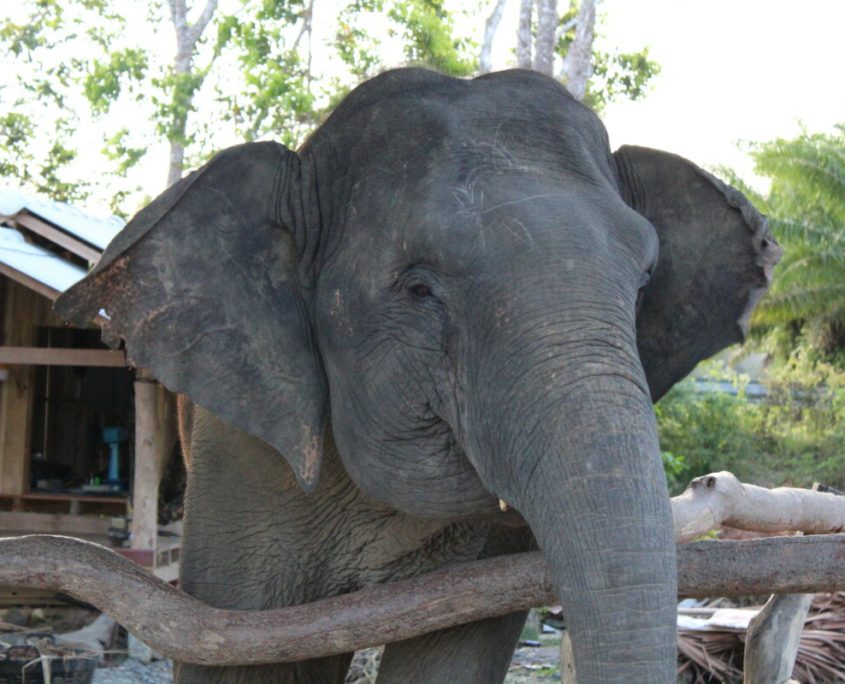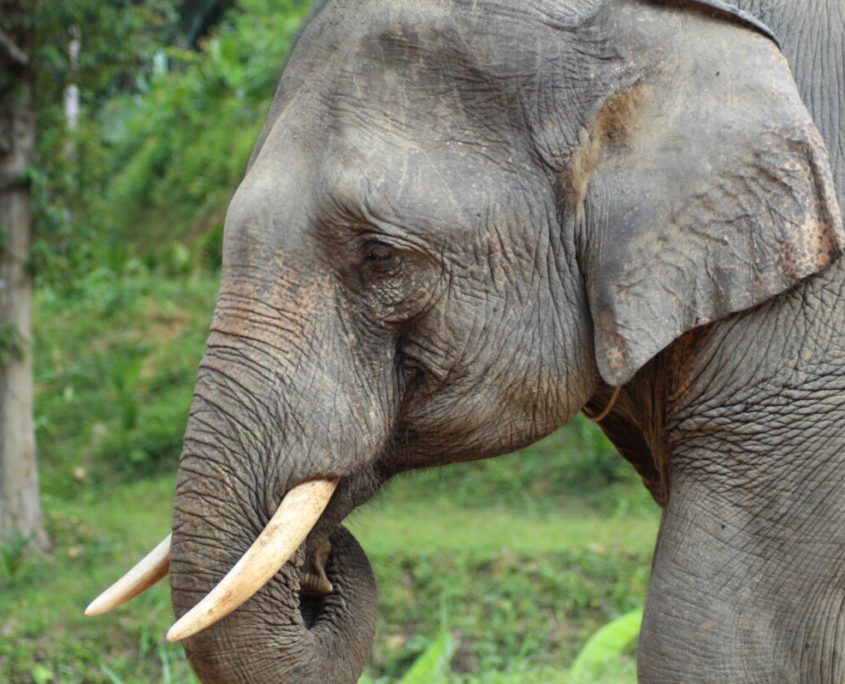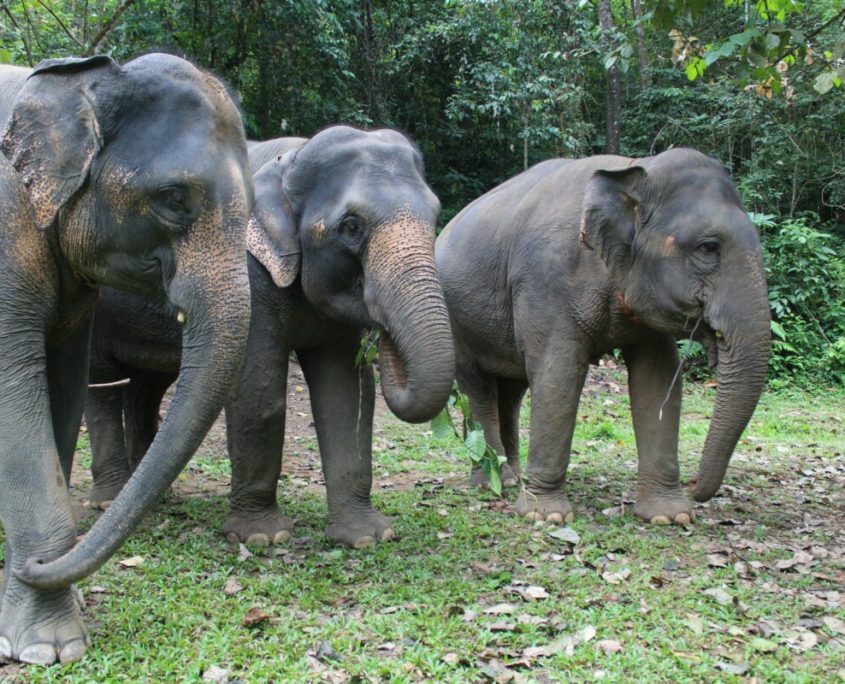My 6 Weeks as an Elephant Vet – Week Five
A blog by veterinary volunteer Vanessa Klabouch, a vet student at TiHo Hannover
30.01.23
The week started quietly. A bunch of packages had arrived over the weekend, including medicines and medical items. First of all, we checked whether everything that was ordered had actually arrived, the whole thing was added to the inventory and then sorted. Our daily equipment from the mobile clinic had to be replenished as well, and some standard medicines had to be packed. After that, we researched on how many establishments with elephants exist in Surat Thani.
Did you know that that the mobile clinic and hospital here covers all districts in the south, from Chumphon all the way down to Narathiwat, and therefore every single elephant in this area. We did some research, starting with Kho Samui. This small island has (at least) 10 elephant camps/parks/sanctuaries itself and who knows how many more that are not listed on Google. We searched further on the mainland for elephants, specifically at Nakhon Si Thammarat and Phuket.
Then we were swept away from our research by a veterinary case. Pum Pui, a female elephant on Phuket, had colic. This time the bloated form. She was not eating, drinking, defecating, or urinating. We packed everything up and left.
When we arrived, Pum Pui stood there not moving, perfectly round, with her mouth open in pain, leaning her head on the beam or biting it. She was clearly in a lot of pain. As she hadn’t taken in any water for a while, we started by inserting the garden hose rectally. Since the elephant’s colon absorbs water quickly, rectal administration of fluids is an excellent way to get fluids into the elephant before taking the time to place a catheter for IV administration. After that, we offered her anti-gas tablets hidden in a banana but she wouldn’t take anything. A catheter was then placed and fluid was provided.
Omeprazole was given first through her catheter as an anti-acid, and then gradually various other drugs:
- Neuxyn (Flunixin = an NSAID: analgesic, anti-phlogistic, anti-pyretic),
- Hepagen (Improves gastrointestinal symptoms including dyspepsia, malabsorption, and anorexia; Stimulate bile secretion; Decrease bile duct construction; Relieve pain),
- Enrofloxacin (antibiotic) and Catosal (supplement).
We also listened to her abdomen, peristalsis could only be heard very faintly. We were happy about every fart and movement in there as the time passed. Her Mahout placed a traditional pain relief on her tummy, whiskey, garlic and onion. They say it heats the skin while soaking in and helps against the gas pressure and pain. Another elephant came for a visit as well, for emotional support and holding trunks. I think all of that made it a little better for Pum Pui. Sometime towards evening, she accepted the bananas with degas. It was a very good sign that she was finally eating again.
Time flew. Around 6 p.m. Fang drove off to get us something to eat. Today we had dinner on the ground in front of our patient. We didn’t let her out of our sight. Every behaviour was documented. We checked her digestion several times. You could slowly hear a little more every time.
It was getting cold so Den lit a fire and we sat there watching her, and waiting, and watching… Finally the redeeming sound, a fart, and splash, … faeces!
Something was moving in the gut again. The stool stank and you could see worms in it. But we were happy about the feaces and left it like this for the moment. The important thing was that her gut started working again. Our patient was getting annoyed as well and ran away more than happy when we were finally done. We made our way back to the hospital and off to bed.
31.01.23
Tuesday started quietly again. Since we were told that an elephant would be arriving at the hospital for treatment, we carried on where we left of yesterday, sorting through medical supplies. For some reason though, the elephant could not come and we headed out in the mobile clinic at midday.
“Sido” Beckham, a bull elephant, was today’s case. In Thai, Sido means “a bull with none or very small tusks”. Plai would be the term for one with large tusks and Pang are the female elephants. Beckham was 17, a well-trained logging elephant with a tear in the sole of his hind foot.
On closer inspection, it could be seen that the injury was mostly dry and did not require treatment. Dr. Mink administered supplements and advised the mahout to always clean the area thoroughly. It would peel off as soon as it is completely dry. If there are problems he should, of course, contact us.
We went to our next patient, “Plai” Kaidam. Another logging bull that had foot problems, too. Look at that magnificent specimen, with his beautiful veins (below). Unfortunately, they only look like this in young animals. It isn’t always that easy to take blood.
Kaidam had two wounds on his hind legs which were dry on the outside but not yet healed on the inside. Cleaning was also important here. In addition, he had a nail crack, which had to be cut out by the mahout at this point. But for our safety we had to stay away. The exact procedure was explained to the mahout for him to do later and, apart from a little poke to get his vitamins, “Plai” Kaidam managed to survive our visit. I’m sure much to his surprise!
On the way back to the hospital we drove past two elephants that were travelling on the road. With a friendly greeting, we were asked to spontaneously take a look at one of the two bulls, Nam Petch. He had a slight limp in the right rear which was caused by an injury and swelling. Our patient received anti-inflammatories and was told to rest. But the whole thing wasn’t too bad. The lameness could hardly be seen (take a look at the video and see for yourself).
At home, we quickly jumped into fresh clothes because we planned on going to a BBQ seafood all-you-can-eat buffet. It was awesome and super yummy. We all ate to the max and tumbled into bed in a food coma. We had so much fun that evening.
01.02.23
We visited 4 camps today. At the first one, there was Nam Wan, a 13 year old female tourist elephant who was hardly drinking and only eating a little. She showed signs of dehydration. Her skin was dry, her eyes were caved in and her trunk was dry, too. She had a CRT (capillary refill time) of 4sec and we estimated her dehydration between 6-8%. Since she was unfortunately busy at work, an infusion was not possible. We therefore recommended that the mahout stimulate her thirst. Slightly salted tamarind is ideal for this and helps to regain the natural feeling of thirst. In addition, banana trees should be fed, which contain a lot of water, ideally mixed with a little water when cut. Dr Mink took blood to rule out an organic cause, but there had also just been some really hot days, especially for a working elephant. Another animal could also be seen sucking the saliva out of its mouth and then spreading it on its body to cool off.
To treat a dehydrated elephant, you have to multiply the bodyweight with percent of dehydration, and that equals the amount of fluid that should be replaced. Dehydration is classified as mild from 5-7% where elephants show depression, a dry mucous membrane and occasionally a slower capillary refill time. Moderate dehydration from 8-10% is characterized by an even slower capillary refill of up to 4s and stronger depression. With more than 10% the patient will be moribund and capillary refill 5s. A blood sample to analyse the packed cell volume and total protein will help evaluate kidney parameters and can indicate a reason for dehydration if it’s not due to a lack of water availability. But when evaluating blood you have to be aware that Asian Elephants, according to reports, have a low serum osmolarity and polymorphism in albumin, and the erythrocyte volume is three times that of horses.
Because of the bodyweight, the volume substituted can reach high amounts, which can be challenging in the field, so multiple catheters should be placed (using both ears). The Venae auriculares are the most common in this case but the medial saphenous vein can be used for IV bolus as well. Subcutaneous fluid substitution is not suitable for an elephant because of a small subcutaneous space and thick skin that can’t be pulled up as easily as it is with dogs and cats. But as I already said rectal absorption works very well and can easily be performed with a water hose.
Tong Kam, the next patient, whom we had already visited 4 weeks ago had back problems again. You could feel the heat around the spot. We asked the elephant to be released from work to recover. He was also given NSAIDs and massage oil to relax his muscles.
The final elephant here, Guitar, had gadflies again. We provided him with ivermectin and supplements.
In the second camp, there was a strange case. A swollen vulva. However, no pain reaction was detectable on palpation, and reddening and swelling comparable to an insect bite could be seen. The scratching behaviour of our patient with her foot confirmed this assumption even more. However, since this lady was mated 5 months ago and pregnancy could not be ruled out, we could not administer any anti-inflammatory drugs, so we could only treat her locally.
Two other camps with residents were only briefly visited for anti-parasitics and vitamins, and with that our day drew to a close. Another exciting day with many cool cases here at STEFT came to an end.
02.02.23
Thursday was super busy again. It was time for general health check-ups at a few facilities. 4 camps on Phuket, 20 elephants in total. Deworming, vitamins, other supplements, and anti-parasitics, … and for the new volunteers, 20 times the opportunity to practice a general examination.
In a group of 8 animals, there was just lice infestation. Otherwise, everyone was fine, but the constant itching was annoying for the big ones, of course.
The two young animals in particular seemed stressed out. The two little ones also received vitamin C to strengthen their immune system and, of course, all of them got ivermectin against the lice. The dose was adjusted to their weight, but was reduced a bit for the little ones just to be on the safe side.
In another camp, a patient had multiple abscesses that luckily did not require treatment. However, the cause was unclear. Of course, injuries that become infected or a weak immune system with poor lymphatic drainage are possible, but it was hard to say for sure. She received supplements and from there we will just have to wait to and see how it goes.
We treated a few nail cracks again, but otherwise, everything was great. Some more information on nailcracks: (I know I have already been talking about them but they are pretty common and can be treated appropriately if you know how)
Both vertical and horizontal cracks occur but vertical cracks appear more often. In the majority of cases that I have seen, they began at the bottom and extended proximally, but it could happen the other way around starting at the cuticle. The depth can reach from superficial to the corium and will cause more or less trouble depending on the depth reached. It can have various reasons for trauma, such as overgrowth, nutrition or even genetics.
Superficial cracks can be treated with a hoof knife as I already mentioned, by cutting it out to take the weight off this area of the nail. The surface of the nail shouldn’t be rasped in order to keep its protectional function. If the crack reaches the corium, it should be grooved out until all remnants are gone (black tracks) and lidocaine needs to be applied for local anaesthesia. Then you have to start rasping the surface of the crack until the edges reach the corium. In addition, in this kind of crack, the distal nail has to be shortened to avoid pressure. If the crack did not reach to the cuticle, its possible to place a horizontal furrow at the proximal end of the crack in order to stop it from breaking up further. There are different opinions if treatments that are used in horses, like clips, screws, tension wires and so on work in elephants. Dr. Aon told us about a case in which the tension wires did their job pretty well combined with the treatment described before.
I spent the end of the day by the sea again. In my opinion, you can never watch too many sunsets! Maybe I should have left when I noticed the first thick black clouds, but it was so beautiful there. On the way back the nice Thai downpour started, but who cares, I still had my bikini underneath from the sunset swim anyway. I guess the Thais thought I was crazy when I jumped around in the rain with my headset on, listening to music. But I love summer rain!
When I got home, P’ Nongs food was already waiting for me, perfect timing.
03.02.23
Nothing was going on today. No calls. So we’re busy again with counting pills, med stock, paperwork… Oh yes, and these pretty new cards that are now part of everyday equipment. Each of our patients (or their mahout) gets one of these, and as well as the elephant data, every treatment is entered here, like in a patient file. The mahout then keeps this so that we know what was done for our next visit and also another veterinarian has some information about previous treatments.
We were allowed to start the weekend early. In the evening we went to Phang Nga where we spent the night, so we could be ready for the morning tour very early. In the evening I watched the elephants going crazy in the water, it was amazing seeing them having so much fun, they were so playful and splashing around, climbing on each other. The sunset over the hills was incredible. We spent the evening with Anna (tour guide at Phang Nga) and Jake having dinner, talking and watching “how to train your dragon” until we found the way to our jungle residence in the middle of the night.
We got up early the next day, it was dreamy again. The mornings in the jungle are simply something very special. And walking an elephant out of the jungle is as a volunteer said “a once in a lifetime experience”. Come and join us and you will experience it yourself.
But that wasn’t the only adventure of this weekend; we went on a snorkelling boat trip as well. Starting at Natai, we experienced breathtaking secluded reefs, indescribable underwater worlds in every blaze of colour, and lots of fun with the group – it was perfect. It’s a shame that the other volunteers had to go back home again on Sunday. New volunteers are on on their way though, who I’m sure are just as excited as I am for the upcoming week’s cases.
